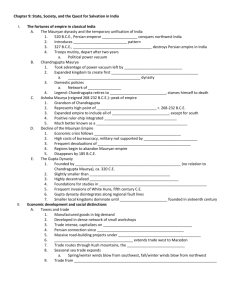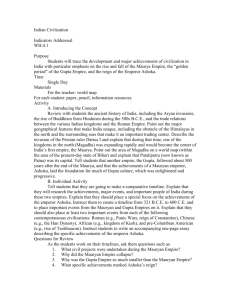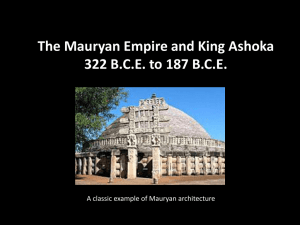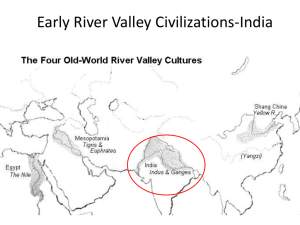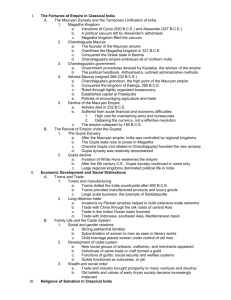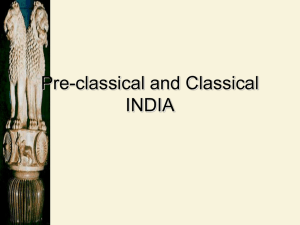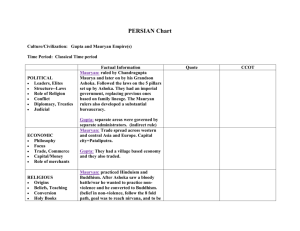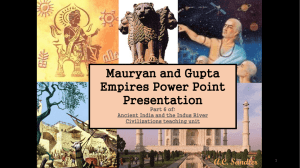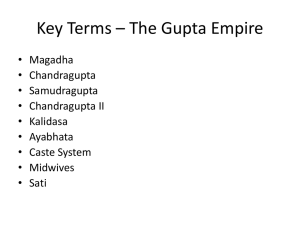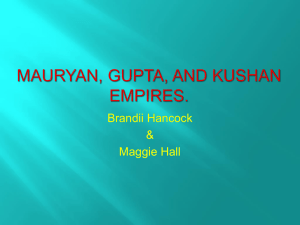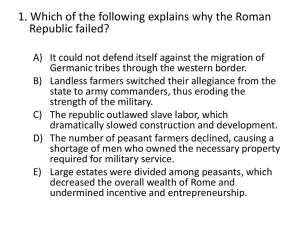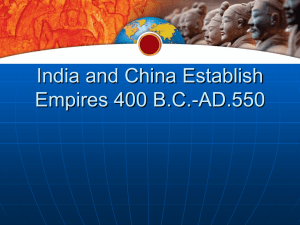AP World History POD #3 – River Civilizations in Asia
advertisement
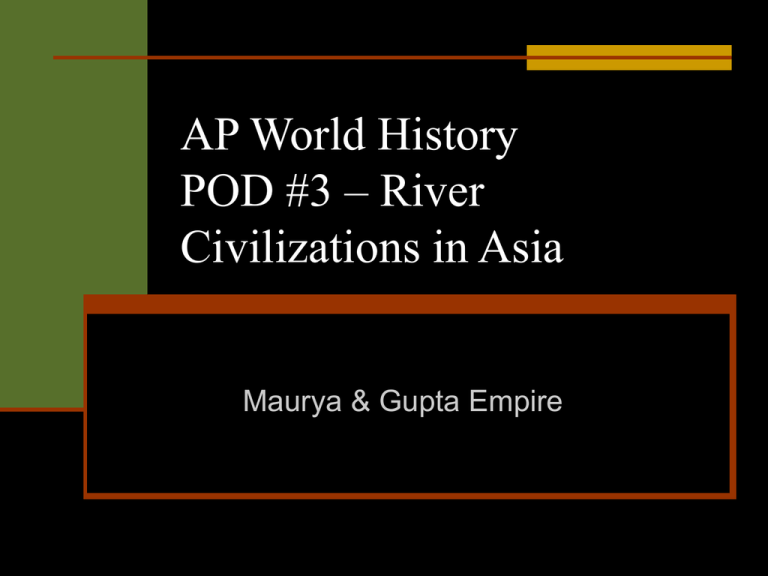
AP World History POD #3 – River Civilizations in Asia Maurya & Gupta Empire Class Discussion Questions Bulliet et. al. – “Imperial Expansion and Collapse, 324 B.C.E. – 650 C.E.”, pp. 188-197 Political Fragmentation in India “Political unity in India, on those rare occasions when it has been achieved, has not lasted long. A number of factors have contributed to India’s habitual political fragmentation. Different terrains called forth varied forms of organization and economic activity, and peoples occupying diverse zones differed in language and cultural practices. Perhaps the most significant barrier to political unity lay in the complex social hierarchy. Individuals identified themselves primarily in terms of their class and caste; allegiance to a higher political authority was secondary.” (Bulliet, p. 188) Mauryan Empire, 324-184 B.C.E. Kingdom of Magadha – located in eastern India south of the Ganges began to rise to power as a result of wealth based on agriculture, iron mines and strategic location astride the trade routes of the eastern Ganges Basin Chandragupta Maurya (Vaishya or Shudra caste) gained control of Magadha and created India’s first centralized empire Chandragupta followed in the lead of Alexander the Great by invading the Punjab while his successors Bindusara and Ashoka extended the empire throughout the entire subcontinent except the very southern tip India would not be united in an empire this large again until the arrival of the Mughals Mauryan Foreign Policy Arthashastra – a treatise on government said to be written by a crafty old Brahmin named Kautilya, an advisor to Chandragupta designed to help him in his conquests and consolidation of power Mandala theory of foreign policy – “MY ENEMY’S ENEMY IS MY FRIEND” Advocated increasing the collection of tax revenues and advocates the use of spies to keep watch on all within the kingdom Mauryan Finances Taxes levied at a rate of ¼ of the harvest used to support the king and government Additional revenue raised from tolls on trade, government control and monopoly of mining, liquor sales and the manufacture of weapons Fees charged for the use of irrigation networks and systems Standard coinage used to pay government and military personnel (also encouraged and promoted trade) Mauryan Government Close relatives and associates of the king governed administrative districts based on traditional ethnic boundaries Imperial Army with an infantry, cavalry and chariot divisions and the fearsome new element of war elephants helped to secure power and control Capital city of Pataliputra was governed by six committees with responsibility for manufacturing, trade, sales, taxes, the welfare of foreigners, and the registration of births and deaths Ashoka Grandson of Chandragupta Engaged in military campaigns to extend the boundaries of the empire Became overwhelmed and disheartened by the heavy casualties and brutality of these wars and converted to Buddhism and embraced the idea of nonviolence, morality, moderation and religious toleration in both government and private life Warning – “the king, remorseful as he is, has the strength to punish the wrongdoers who do not repent” Collapse of the Mauryan Empire After the death of Ashoka the subcontinent once again fragmented politically and became heavily influenced by outsiders Trade routes remained essential as India was still the heartland of the great Silk Roads as well as home to many sea trade routes Guilds of merchants and artisans became influential in this politically fragmented region Significant advancements and innovations in science and technology are rooted in this time period Tamil Kingdoms “The three Tamil Kingdoms of Cholas, Pandyas, and Cheras in the southernmost parts of the peninsula were in frequent conflict with one another and experienced periods of ascendancy and decline, but they persisted in one form or another for over two thousand years.” (Bulliet, p. 191) Gupta Empire, 320-550 C.E. Originated in the Ganges plain with its’ capital at Pataliputra Founded by Chandra Gupta Enjoyed the benefit of sitting on sea and land trade routes just did the Mauryan empire Copied much of the revenue plans and administrative bureaucracy of the Mauryan empire A standing army with a strong cavalry skilled in the use of the bow and arrow maintained tight control of the empire and its’ finances Gupta “Theater State” Limited in its ability to control the outlying frontiers the empire relied on persuading loyalty with the splendor, beauty and orderliness of life at the capital and royal court Created and supported a constant round of solemn rituals, dramatic ceremonies, and cultural events as an advertisement promoting the benefits of association with the empire Redistributed luxury goods and profits garnered from control of trade routes to their dependents to secure favor and loyalty Gupta Innovation & Technology Supported and financed astronomers, mathematicians, scientists, poets, and dramatists Concept of zero Arabic numerals Place value notation Compilation of law codes and grammatical texts Gupta Women As in Mesopotamia, Greece and China, several factors including urbanization, more complex political and social structures and the emergence of a nonagricultural middle class that placed a high value on the acquisition and inheritance of property – led to a loss of women’s rights and an increase in male control over women’s behavior Could not own or inherit property Barred from religious ceremonies Obey first her father, then her husband, and finally her sons Arrange marriage at a young age Sati – a widow was expected to cremate herself on her husband’s funeral pyre Gupta Religion Mauryans were Buddhists Guptas were Hindus Reemergence of the caste system Designed, developed and built the classical style of Hindu temples Allowed for religious toleration Gupta Decline Resulted from continual pressure and invasion by nomads from the steppes of Central Asia Local loyalty shifted to rich landholding Brahmins The region returned to a politically fragmented decentralized state
